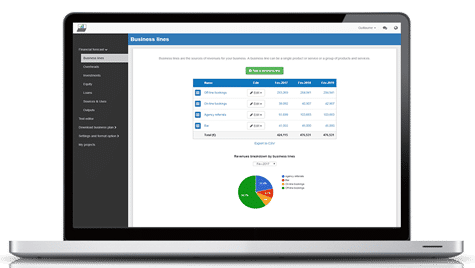How to create a financial forecast for a stage-shifting and rigging company?
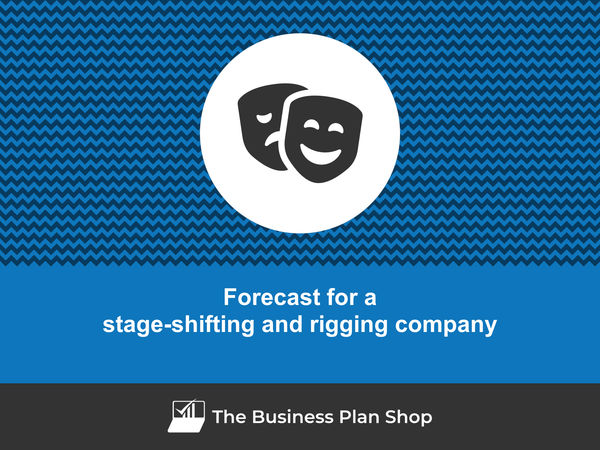
Developing and maintaining an up-to-date financial forecast for your stage-shifting and rigging company is key in order to maintain visibility on your business’s future cash flows.
If you feel overwhelmed at the thought of putting together a stage-shifting and rigging company financial forecast then don’t worry as this guide is here to help you.
We'll cover everything from: the main objectives of a financial forecast, the data you need to gather before starting, to the tables that compose it, and the tools that will help you create and maintain your forecast efficiently.
Let's get started!
Why create and maintain a financial forecast for a stage-shifting and rigging company?
Creating and maintaining an up-to-date financial forecast is the only way to steer the development of your stage-shifting and rigging company and ensure that it can be financially viable in the years to come.
A financial plan for a stage-shifting and rigging company enables you to look at your business in detail - from income to operating costs and investments - to evaluate its expected profitability and future cash flows.
This gives you the visibility needed to plan future investments and expansion with confidence.
And, when your trading environment gets tougher, having an up to date stage-shifting and rigging company forecast enables you to detect potential upcoming financing shortfalls in advance, enabling you to make adjustments or secure financing before you run out of cash.
It’s also important to remember that your stage-shifting and rigging company's financial forecast will be essential when looking for financing. You can be 100% certain that banks and investors will ask to see your numbers, so make sure they’re set out accurately and attractively.
Need a convincing business plan?
The Business Plan Shop makes it easy to create a financial forecast to assess the potential profitability of your projects, and write a business plan that’ll wow investors.
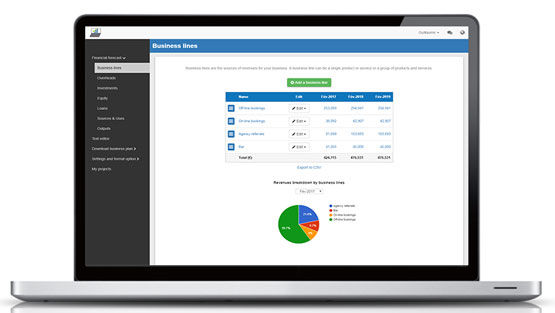
What information is used as input to build a stage-shifting and rigging company financial forecast?
A stage-shifting and rigging company's financial forecast needs to be built on the right foundation: your assumptions.
The data required to create your assumptions will depend on whether you are a new or existing stage-shifting and rigging company.
If you are creating (or updating) the forecast of an existing stage-shifting and rigging company, then your main inputs will be historical accounting data and operating metrics, and your team’s view on what to expect for the next three to five years.
If you are building financial projections for a new stage-shifting and rigging company startup, you will need to rely on market research to form your go-to-market strategy and derive your sales forecast.
For a new venture, you will also need an itemised list of resources needed for the stage-shifting and rigging company to operate, along with a list of equipment required to launch the venture (more on that below).
Now that you understand what is needed, let’s have a look at what elements will make up your stage-shifting and rigging company's financial forecast.
The sales forecast for a stage-shifting and rigging company
The sales forecast, also called topline projection, is normally where you will start when building your stage-shifting and rigging company financial forecast.
Creating a coherent sales projection boils down to estimating two key drivers:
- The average price
- The number of monthly transactions
To do this, you will need to rely on historical data (for an existing business), market research data (for both new and existing stage shifting and rigging companies), and consider the elements below:
- Event seasonality: As a stage-shifting and rigging company, your sales may be affected by the seasonality of events. For example, the summer months tend to be busier with outdoor concerts and festivals, while the winter months may see a decrease in demand for your services.
- New venue construction: The construction of new event venues in your area could impact your average price and number of monthly transactions. If there are more venues being built, it could lead to an increase in demand for your services, allowing you to charge higher prices and potentially increase your number of monthly transactions.
- Competition: The level of competition in your area may also affect your sales. If there are many other stage-shifting and rigging companies in your area, it may be more difficult to charge higher prices and secure monthly transactions. Conversely, if you have little competition, you may be able to charge higher prices and increase your number of monthly transactions.
- Technological advancements: New technologies and equipment in the event industry could also impact your business. If there are advancements in stage-shifting and rigging technology, it could allow you to offer more efficient and specialized services, potentially leading to higher prices and more monthly transactions.
- Economic climate: The overall economic climate can also play a role in your sales forecast. In times of economic downturn, event organizers may have smaller budgets, leading to a decrease in demand for your services and potentially lower prices. On the other hand, during a strong economy, event organizers may have more disposable income, allowing you to charge higher prices and potentially increase your number of monthly transactions.
After the sales forecast comes the operating expenses budget, which we will now look into in more detail.
Need a convincing business plan?
The Business Plan Shop makes it easy to create a financial forecast to assess the potential profitability of your projects, and write a business plan that’ll wow investors.

The operating expenses for a stage-shifting and rigging company
The next step is to estimate the costs you’ll have to incur to operate your stage-shifting and rigging company.
These will vary based on where your business is located, and its overall size (level of sales, personnel, etc.).
But your stage-shifting and rigging company's operating expenses should normally include the following items:
- Staff costs: includes wages, salaries, benefits, and training for employees who operate the stage-shifting and rigging equipment.
- Accountancy fees: covers the costs of hiring a professional accountant to manage your financial records and tax filings.
- Insurance costs: includes liability insurance to protect against any accidents or damages that may occur during stage-shifting and rigging operations.
- Software licenses: covers the costs of purchasing and renewing licenses for software used in the stage-shifting and rigging process, such as CAD software for designing rigging plans.
- Banking fees: includes fees for maintaining business bank accounts and using other financial services, such as wire transfers.
- Rent: covers the cost of leasing a space for storage of equipment and office space for administrative tasks.
- Utilities: includes electricity, water, and other utility bills for the office and storage space.
- Vehicle expenses: includes fuel, maintenance, and insurance for any vehicles used for transporting equipment to and from job sites.
- Materials and supplies: covers the costs of purchasing necessary materials such as ropes, cables, and hardware for rigging operations.
- Marketing and advertising: includes expenses for promoting your company and services, such as creating a website, printing business cards, and attending trade shows.
- Training and certifications: covers the costs of training employees and obtaining necessary certifications for safe and efficient stage-shifting and rigging operations.
- Professional fees: includes fees for hiring legal counsel or consultants for specialized services related to the stage-shifting and rigging industry.
- Travel expenses: covers the costs of travel for employees to job sites or for attending conferences and training workshops.
- Safety equipment: includes the cost of purchasing and maintaining safety equipment, such as harnesses and hard hats, for employees to use during rigging operations.
- Office supplies: covers the costs of purchasing necessary office supplies, such as paper, ink, and pens, for administrative tasks.
This list is not exhaustive by any means, and will need to be tailored to your stage-shifting and rigging company's specific circumstances.
What investments are needed to start or grow a stage-shifting and rigging company?
Your stage-shifting and rigging company financial forecast will also need to include the capital expenditures (aka investments in plain English) and initial working capital items required for the creation or development of your business.
For a stage-shifting and rigging company, these could include:
- Stage Equipment: This includes items such as lighting, sound systems, and stage rigging equipment. These are essential for any stage-shifting and rigging company and can be a significant capital expenditure.
- Trucks and Trailers: As a stage-shifting and rigging company, you will need reliable transportation to move your equipment from one location to another. This can include trucks and trailers specifically designed to transport heavy equipment.
- Stage Platforms: These are used to create different levels on the stage and can be customized to fit the specific needs of a production. They can be a significant capital expenditure for a stage-shifting and rigging company.
- Lifting Equipment: Lifting equipment such as cranes or hoists are essential for moving heavy equipment and stage sets. These can be a significant capital expenditure but are necessary for the safe and efficient operation of a stage-shifting and rigging company.
- Storage Containers: As a stage-shifting and rigging company, you will need a place to store your equipment when it's not in use. This can include storage containers or warehouses, which can be a significant capital expenditure.
Again, this list will need to be adjusted according to the size and ambitions of your stage-shifting and rigging company.
Need a convincing business plan?
The Business Plan Shop makes it easy to create a financial forecast to assess the potential profitability of your projects, and write a business plan that’ll wow investors.

The financing plan of your stage-shifting and rigging company
The next step in the creation of your financial forecast for your stage-shifting and rigging company is to think about how you might finance your business.
You will have to assess how much capital will come from shareholders (equity) and how much can be secured through banks.
Bank loans will have to be modelled so that you can separate the interest expenses from the repayments of principal, and include all this data in your forecast.
Issuing share capital and obtaining a bank loan are two of the most common ways that entrepreneurs finance their businesses.
What tables compose the financial plan for a stage-shifting and rigging company?
Now let's have a look at the main output tables of your stage-shifting and rigging company's financial forecast.
The projected profit & loss statement
The projected profit & loss shows how profitable your stage-shifting and rigging company is likely to be in the years to come.
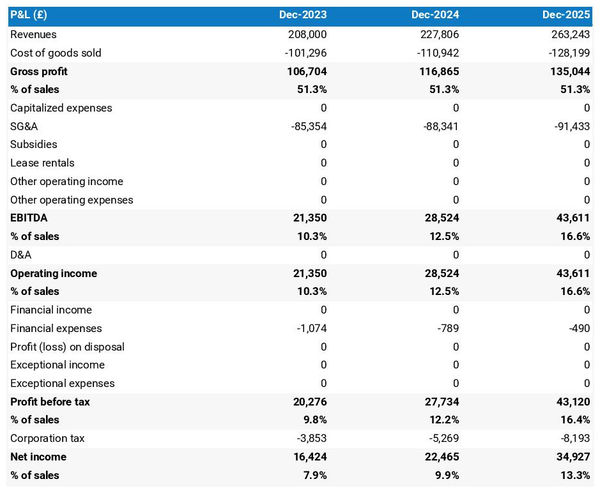
For your stage-shifting and rigging company to be financially viable, your projected P&L should ideally show:
- Sales growing above inflation (the higher the better)
- Profit margins which are stable or expanding (the higher the better)
- A net profit at the end of each financial year (the higher the better)
This is for established stage shifting and rigging companies, there is some leniency for startups which will have numbers that will look a bit different than existing businesses.
The projected balance sheet
Your stage-shifting and rigging company's projected balance sheet provides a snapshot of your business’s financial position at year-end.
It is composed of three types of elements: assets, liabilities and equity:
- Assets: represent what the business possesses including cash, equipment, and accounts receivable (money owed by clients).
- Liabilities: represent funds advanced to the business by lenders and other creditors. They include accounts payable (money owed to suppliers), taxes payable and loans from banks and financial institutions.
- Equity: is the combination of what has been invested by the business owners and the cumulative profits and losses generated by the business to date (which are called retained earnings). Equity is a proxy for the value of the owner's stake in the business.
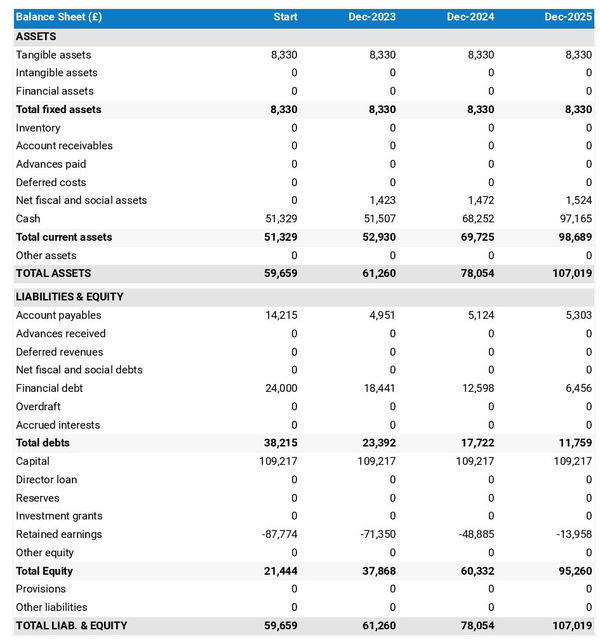
The projected cash flow statement
A projected cash flow statement for a stage-shifting and rigging company is used to show how much cash the business is generating or consuming.

The cash flow forecast is usually organised by nature to show three key metrics:
- The operating cash flow: do the core business activities generate or consume cash?
- The investing cash flow: how much is the business investing in long-term assets (this is usually compared to the level of fixed assets on the balance sheet to assess whether the business is regularly maintaining and renewing its equipment)?
- The financing cash flow: is the business raising new financing or repaying financiers (debt repayment, dividends)?
Cash is king and keeping an eye on future cash flows is imperative for running a successful business. Therefore, you should pay close attention to your stage-shifting and rigging company's cash flow forecast.
If you are trying to secure financing, note that it is customary to provide both yearly and monthly cash flow forecasts in a financial plan - so that the reader can analyze seasonal variation and ensure the stage-shifting and rigging company is appropriately capitalised.
Need a convincing business plan?
The Business Plan Shop makes it easy to create a financial forecast to assess the potential profitability of your projects, and write a business plan that’ll wow investors.

Which tool should you use to create your stage-shifting and rigging company's financial projections?
Building a stage-shifting and rigging company financial forecast is not difficult provided that you use the right tool for the job. Let’s see what options are available below.
Using online financial forecasting software to build your stage-shifting and rigging company's projections
The modern and easiest way is to use an online financial forecasting tool such as the one we offer at The Business Plan Shop.
There are several advantages to using specialised software:
- You can easily create your financial forecast by letting the software take care of the financial calculations for you without errors
- You have access to complete financial forecast templates
- You get a complete financial forecast ready to be sent to your bank or investors
- You can easily track your actual financial performance against your financial forecast, and recalibrate your forecast as the year goes by
- You can create scenarios to stress test your forecast's main assumptions
- You can easily update your forecast as time goes by to maintain visibility on future cash flows
- You have a friendly support team on standby to assist you when you are stuck
- It’s cost-efficient and much cheaper than using an accountant or consultant (see below)
If you are interested in this type of solution, you can try our projection software for free by signing up here.
Hiring a financial consultant or chartered accountant
Hiring a consultant or chartered accountant is also an efficient way to get a professional stage-shifting and rigging company financial projection.
As you can imagine, this solution is much more expensive than using software. From experience, the creation of a simple financial forecast over three years (including a balance sheet, income statement, and cash flow statement) is likely to start around £700 or $1,000 excluding taxes.
The indicative estimate above, is for a small business, and a forecast done as a one-off. Using a financial consultant or accountant to track your actuals vs. forecast and to keep your financial forecast up to date on a monthly or quarterly basis will naturally cost a lot more.
If you choose this solution, make sure your service provider has first-hand experience in your industry, so that they may challenge your assumptions and offer insights (as opposed to just taking your figures at face value to create the forecast’s financial statements).
Why not use a spreadsheet such as Excel or Google Sheets to build your stage-shifting and rigging company's financial forecast?
Creating an accurate and error-free stage-shifting and rigging company financial forecast with a spreadsheet is very technical and requires a deep knowledge of accounting and an understanding of financial modelling.
Very few business owners are financially savvy enough to be able to build a forecast themselves on Excel without making mistakes.
Lenders and investors know this, which is why forecasts created on Excel by the business owner are often frowned upon.
Having numbers one can trust is key when it comes to financial forecasting and to that end using software is much safer.
Using financial forecasting software is also faster than using a spreadsheet, and, with the rise of artificial intelligence, software is also becoming smarter at helping us analyse the numbers to make smarter decisions.
Finally, like everything with spreadsheets, tracking actuals vs. forecasts and keeping your projections up to date as the year progresses is manual, tedious, and error-prone. Whereas financial projection software like The Business Plan Shop is built for this.
Need a convincing business plan?
The Business Plan Shop makes it easy to create a financial forecast to assess the potential profitability of your projects, and write a business plan that’ll wow investors.

Use our financial projection templates for inspiration
The Business Plan Shop has dozens of financial forecasting templates available.
Our examples contain both the financial forecast, and a written business plan which presents, in detail, the company, the team, the strategy, and the medium-term objectives.
Whether you are just starting out or already have your own stage-shifting and rigging company, looking at our template is always a good way to get ideas on how to model financial items and what to write when creating a business plan to secure funding.

Takeaways
- A financial forecast shows expected growth, profitability, and cash generation metrics for your stage-shifting and rigging company.
- Tracking actuals vs. forecast and having an up-to-date financial forecast is key to maintaining visibility on your future cash flows.
- Using financial forecasting software is the modern way of creating and maintaining financial projections.
We hope that this guide helped you gain a clearer perspective on the steps needed to create the financial forecast for a stage-shifting and rigging company. Don't hesitate to contact us if you have any questions!
Need a convincing business plan?
The Business Plan Shop makes it easy to create a financial forecast to assess the potential profitability of your projects, and write a business plan that’ll wow investors.

Also on The Business Plan Shop
- Financial forecast example
- How to project sales for a business?
- Financial forecast template for a business idea
Know someone who runs a stage-shifting and rigging company? Share our business guide with them!

